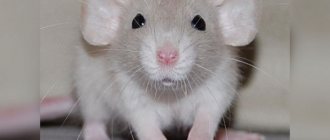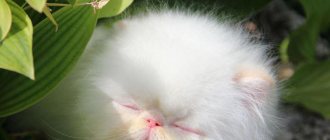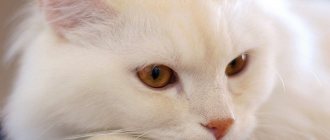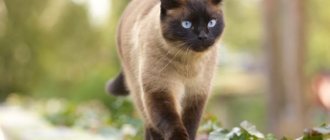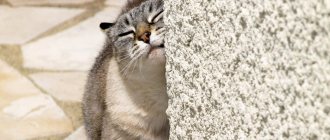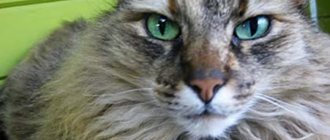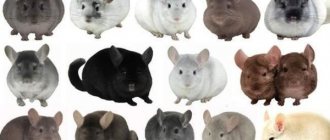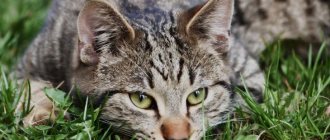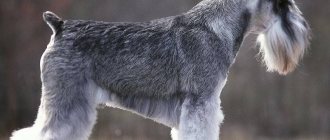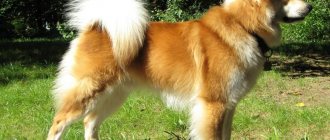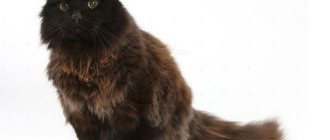Cat breeds with a flattened face
Brachycephaly is a scientific term denoting a special structure of the skull, which is essentially a genetic disorder. Literally, this term can be translated as “short-headed.” In animals that carry this trait, the front part of the skull is flattened, and the width of the head is more than 80% of the height. There are not many breeds with such a muzzle structure.
Persian cat
The history of the Persian breed goes back hundreds of years, and these cats have always been incredibly popular. The Persian's face has a slightly upturned nose and large, round eyes. Their fur is long, silky, and can reach up to 12 cm in length. The body is squat, the limbs are short. The colors are very diverse. These cats may have:
- classic type of muzzle - the nose is located below eye level,
- modern - the edge of the nose is at the same level with the lower eyelid,
- extreme - the nose is concave and located in line with the inner corners of the eyes.
These representatives of the cat family can be called homebodies. By nature, “Persians” are calm and balanced. Playful little individuals become more sedate with age, preferring an evening spent in the arms of the owner to active leisure. There are no problems with education. Pets are unobtrusive, rarely meow and are not prone to aggression.
The Persian cat of the so-called red color is a friendly and beautiful animal
Exotic
The exotic breed, or exotic shorthair, is the result of crossing an American shorthair and a Persian cat. The entire appearance of the animal, except for the fur, resembles the appearance of an extreme type of “Persian”. The same flattened muzzle with an upturned nose and expressive eyes, the same squat body and short legs.
By nature, these animals are calm, affectionate and playful. Moreover, they remain active even into adulthood. They rarely speak and are very attached to their owner. Get along well with other pets.
The short-haired exotic breed is called the “lazy man's Persian” - they look as cute as Persian cats, but their short fur does not require complex care
Himalayan cat
Not all international organizations recognize the Himalayan as a separate cat breed. Some consider it only a variation of the Persian. Himalayan cats, bred in the 50s of the last century, were the result of crossing the Siamese and Persian breeds. The flattened muzzle, blue eyes and long fur of the “Persians” are combined in this breed with the Siamese color. These creatures are very calm and peaceful. They easily tolerate any manipulation by humans and are loved by children.
Himalayan cats have long Persian hair and a color characteristic of the Siamese breed.
British Shorthair
The British breed is a brachycephalic breed with short fur. The characteristic features of the appearance of the “British” are a wide, rounded muzzle with slightly sagging cheeks, a squat body and short limbs. The range of colors of the British breed is quite wide. The classic coat is blue, but cream, red, black, lilac and the so-called tabby color are also common.
The nature of the breed is easygoing, the “British” are well-mannered, neat and clean. They tolerate loneliness calmly. Kittens are incredibly playful and funny. They are non-conflict, patient, and rarely use their claws.
A cat of the British breed of classic blue color is a frequent hero of television advertisements.
Scottish fold cats
A characteristic feature of the Scottish Fold breed is the unusual structure of the ears - they are inclined forward and downward. The more closely the ears touch the head, the more valuable the pet is considered. The face of this cat is not as flattened as, for example, that of Persians or exotics. The body of the Scottish Fold is quite powerful, the fur is short, incredibly thick and soft. The range of colors is quite extensive. Their fur can be one color - blue, chocolate, black, multi-colored and striped (tabby, marble, brindle).
Representatives of the Scottish breed with straight ears are called Scottish Straight. Breeding requires the participation of animals with different ear structures in order to avoid the appearance of offspring with various pathologies.
Representatives of the Scottish breed are unpretentious, have a calm and balanced character, and are attached to people. Kittens are extremely playful and trainable. They are considered good companions for children. It is typical for the “Scots” to stand on their hind legs and sleep on their backs, which looks very cute and funny.
The blue Scottish cat is similar to the British cat, but has curled ears.
Wild cat manul
In nature, Pallas' cats, wild cats that live in Central Asia, have a flattened muzzle. This is a rather massive animal with thick striped fur. The strong jaw characteristic of the brachycephalic type allows the hunter cat to hold his prey more firmly. In addition, this shape of the muzzle allows you to breathe through your mouth without loosening your grip even for a second. The animal is listed in the Red Book as a rare species.
The wild cat Pallas's cat is listed in the Red Book of Russia
Minuses
- Since the flattened shape of the face is not natural for cats, some problems arise from this. And sometimes in the literal sense of the word. These cats often have problems with nasopharyngeal congestion. A cat may snore and snort in its sleep. It's noisy.
- The brachycephalic type of muzzle in some people causes associations with an angry facial expression. This cat seems to be constantly dissatisfied with something. Or, on the contrary, it looks very naive. This form is also called a “doll” because it can resemble a child’s face. The associations are completely contradictory to each other, but they do exist.
There are not as many breeds with a flattened muzzle as you might think. In this article we will describe the most famous of them.
Features of caring for cats with a flattened face
A good owner is obliged to take care of his pet, no matter what breed it is. Regular brushing, cleaning of eyes, ears, bathing and some other manipulations are the key to a magnificent appearance, good mood and health of the animal. Caring for brachycephalic cats has certain nuances.
Eye care
Regular and proper eye care for brachycephalics and mandatory examinations by a veterinarian can prevent the occurrence of serious pathologies. Constant and profuse lacrimation is a typical problem for short-headed animals, especially Persians and exotics. With the usual structure of the muzzle, tears, passing through the appropriate channels, penetrate the nose. In brachycephalics, these canals are deformed, so tears cannot pass through them normally and leave them in a timely manner. This increases the risk of eye infection. In addition, even transparent discharge tends to stain the animal’s fur, which negatively affects its appearance.
It is a mistaken belief that the eyes of “Persians” and other cats with a similar facial structure need to be washed with water. Frequent washing leads to disruption of microflora and the development of inflammation. Do not use cotton wool for wiping - its fibers can get into your pet's eyes, as well as wet wipes. It is best to use a soft cloth or paper towel to care for your eyes. The fabric can be pre-moistened with special drops or a weak solution of boric acid - no more than 0.03%, or the eyelids can be treated with Optic Gel.
Due to the fact that the eyes of all cats with a flattened muzzle are large and slightly bulging, during blinking the eyelids do not completely close the eyeball and a small section of the cornea remains outside. This can be fraught with inflammation of the cornea, and also lead to its chronic necrosis. This condition is characterized by the appearance of black pigment spots. This pathology requires surgical intervention. Timely detection and contact with a specialist will increase the chances of a favorable outcome.
Dental care
Prevention of various dental problems in cats with a flattened muzzle - yellow plaque, tartar - is the inclusion of dry food in the animal's diet. Special stores also sell chewing toys that help keep teeth clean. It is also recommended to brush your teeth with a special brush and toothpaste at least once every 30 days.
Ear care
The ears of brachycephalic cats must be inspected regularly and cleaned once a month or when soiled with cotton swabs. They can be moistened with special products - Otifree, Excel Ear Cleansing Liquid, Ear cleaner or similar, Vaseline oil. Do not penetrate deeply into the animal’s ear canal to avoid injury. It is not recommended to use alcohol products to clean ears.
Nail care
Persians, exotics and other cats must have a scratching post. Also, the claws must be trimmed once a month using a nail clipper - no more than 2 mm and only evenly. If the animal strongly protests against these manipulations, then you can extend the procedure - treat the front paws on one day, and the hind paws on another.
A scratching post will protect furniture and carpets in the house from the claws of a pet.
Fur care
Almost all cats of the brachycephalic type have long, thick hair. If poorly cared for, such fur is prone to matting and matting. The animal should be combed daily, using alternately a wide-toothed comb and a brush with frequent bristles. It is not recommended to use plastic combs because they generate static electricity, which can cause discomfort to your pet.
The procedure must begin with the head, then the back should be treated, then the chest, abdomen and limbs. It would be a good idea to use an antistatic spray every 7 days. The frequency of combing for “British” and “Scots” is 2-3 times a week. Their fur is processed first according to hair growth, and then against hair growth using a comb with medium-frequency teeth and a massage brush. After combing, especially during the molting period, excess fur can be removed with hands soaked in water or a special rubber mitten.
Licking the plush fur of the “British” and “Scots” leads to lumps of fur getting into the stomach, which negatively affects digestion. To prevent this problem, after six months, pets must be accustomed to a paste that tastes good and helps dissolve hairballs.
Bathing
Due to the structural features of the muzzle, pets of the brachycephalic type, especially “Persians” and exotics, are less adapted to self-care. Water treatments for long-haired animals should be carried out every 8-12 weeks. White pets can be bathed more often.
Fill the bath with warm water no more than 10 cm. During bathing, you must ensure that water does not get into the animal’s ears. There are special shampoos for pets with long fur and short hair. It is necessary to rinse the animal as thoroughly as possible - it is important not to leave excess product on the fur. Dry your pet first with a towel and then with a hairdryer.
Nutrition
You can feed cats with a flattened face both natural food and ready-made food. All cats love meat, and it must be present in their diet. You just need to make sure that it is boneless and lean varieties - beef, poultry.
The diet should contain plant foods. The exceptions are potatoes, mushrooms, and eggplant. If your pet is reluctant to eat vegetables, then they must be mixed with meat dishes. Fermented milk products in a cat's diet should only be low in fat. Feeding with porridge is allowed. Prohibited products include:
- smoked meats and any canned food;
- sweets and baked goods;
- seasonings;
- fat meat.
Meat can also be given raw, but frozen for 2-3 days. Chewing such food is good for your pet's jaw.
The presence of clean water in the bowl is mandatory. Due to the predisposition of “Persians” to urolithiasis, you should not give them fish often - once a week is enough. Despite the fact that ready-made premium food contains all the necessary elements, it is not recommended to feed representatives of long-haired breeds only with them. Such a diet can negatively affect the condition of the animal’s fur - it will lose its shine and thickness.
You cannot feed your pet food from a human table.
Additionally, special supplements with seaweed should be included in the diet of Persians, exotics and other representatives of the brachycephalic type - with the exception of light-colored animals due to the risk of darkening the fur. Animals also need calcium. The frequency of food intake for an adult is 3 times a day.
The massive physique of the “British” requires the presence of a large amount of protein in the diet - at least 33% of the total food.
The ideal feeding bowl should be ceramic. It is also important that it be wide enough - then the cat will be able to eat comfortably.
How to care
Caring for cats with a flattened face has a number of features. This must be taken into account to maintain the health of your pet.
- Snub-nosed brachycephals have a sensitive gastrointestinal tract and are very selective in what they eat. Cats with a flattened face prefer to eat super premium dry food or fresh lean meat, sea fish and poultry. In spring and summer, it is recommended to give them fresh vegetables.
- Due to the shortened muzzle, the eyes of brachycephalics are set much closer than nature intended. Therefore, in snub-nosed cats, the functioning of the lacrimal glands is impaired. To avoid the development of inflammatory processes, the eyes of such animals are wiped daily with a cotton swab dipped in chamomile decoction.
- Due to their shortened airways, cats with flattened faces do not tolerate colds well. Therefore, it is recommended to keep snub-nosed animals in warm rooms, away from drafts.
Breathing problems in brachycephalics
One of the main problems for short-headed breeds is breathing problems. The reason for this is the structure of the nostrils and respiratory tract - they are greatly narrowed. All this results in snoring and snoring during sleep and noisy eating. The pet must be carefully protected from colds - with such features, it suffers respiratory diseases more severely than any other animal. Due to deterioration in breathing due to nasal congestion, the cat is forced to breathe through the mouth. This is completely unnatural for cats, and they suffer greatly.
Scientific point of view
Cat with big eyes: big-eyed breeds
The cat’s non-standard flattened muzzle is the result of a strong genetic disorder, which scientists have given their name to: brachycephaly.
For your information! The cat family of this breed inherited this skull shape from their ancestor - the Pallas cat, but this fact has not yet been fully proven.
Flat-faced cats inherited this skull shape from their ancestor, the Pallas cat.
A large number of geneticists and breeders actively fought to ensure that crossings were made only with cats with a flattened muzzle. Thus, they still achieved the consolidation of the brachycephalic features of the skull.
Exotic
Or an exotic shorthair cat. Outwardly it looks like a short-haired Persian. Only her size is smaller and her face is much cuter. Short hair does not require daily grooming and makes keeping the animal easier. The character of these cats is much friendlier than the Persian. They are playful and affectionate and love children.
Colors, like the Persians, can be varied. Up to noble blue. The face is truly doll-like and evokes only tenderness. An excellent breed for a family with children. Exotics are cartoon cats. Children will definitely be delighted with them, and parents will not have to spend a lot of time looking after them.
